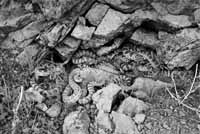Hikers, bikers and dog walkers on south-valley trails should be wary of rattlesnakes dispersing from their dens this time of year. Two dogs were bitten on their noses in Lamb's Gulch west of Hailey last week after rooting around in bushes near a creek.
"Lamb's Gulch is definitely a hotspot for rattlesnakes around here," said Dr. Laurie Breedveld of the Sawtooth Animal Center in Bellevue.
She treated the two dogs with antibiotics and anti-inflammatory medications after they were bitten.
Breedveld said Rock Creek and Carbonate Mountain in Croy Canyon, as well as Slaughterhouse Canyon in Bellevue, are also known to be inhabited by rattlesnakes.
Vaccines, made from a non-native rattlesnake species' venom, can be bought from local veterinarians for about $100.
"Dogs can get really infected after a bite," Breedveld said. "Vaccines seem to help a bit."
The Sun Valley Animal Center reports six to 10 snakebite cases each year, almost always from the south valley.
"They hibernate communally in winter and disperse in summer," said Idaho Fish and Game biologist Mike McDonald.
<
McDonald advises hikers to be aware of where they are stepping in snake-habitat environments, and to not stick hands into rock crevices.
"They are not particularly aggressive," he said. "They don't want to encounter you any more than you want to encounter them."
McDonald said rattlesnakes eat small mammals such as mice, voles, ground squirrels and the occasional bird.
"I suspect that their den is pretty close to that creek in Lamb's Gulch," he said.
Lamb's Gulch is connected to Democrat Gulch, on the north side of Croy Canyon.
Fish and Game Conservation Officer Gary Hompland said rattlesnake bites "seldom" result in a dog's death. He said mortality to humans is even more rare.
"A person would only die from a rattlesnake bite if their immune system was already compromised," Hompland said.
He advised taking small snakes even more seriously than mature ones.
"Venom is more concentrated in young snakes," he said.
Idaho hunting regulations allow for the possession of up to four rattlesnakes of each species at any one time. Up to six rattlesnakes per year can be sold with a hunting license.
Hompland said more can be caught and sold with a commercial license.
"Some people are selling rattlesnake skins and rattles, or stuffing entire specimens for sale," he said. "The venom is used to make anti-venom for snake-bite treatments, but it takes a lot of venom to produce anti-venom."
Tony Evans: tevans@mtexpress.com


 Rattlesnakes live communally in winter and disperse in warmer months.
Courtesy photo.
Rattlesnakes live communally in winter and disperse in warmer months.
Courtesy photo.



































